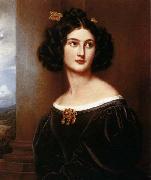Wholesale Oil Painting No Minimum |
|||||||||||
|
|
|||||||||||

|
|||||||||||
|
|
|
||||||||
Joseph StielerGerman Painter, 1781-1858,German painter. In 1798 he studied under Christoph Fesel (1737-1805) in Werzburg and in 1800 with Heinrich Feger in Vienna, where his style was strongly influenced by English portraiture. After he studied in Paris (1807-8) with Fran?ois G?rard the influence of Neo-classicism became apparent in his work. He visited Italy in 1809, 1810 and 1812 to do commissioned portraits for various patrons, among them Prince Eugene de Beauharnais (1809; Munich, Bayer. Nmus.) and Joachim Murat, King of Naples (reg 1808-15). In 1812 he went to Munich where he did work for middle-class clients, the nobility and the royal family of Bavaria (e.g. the portrait of Maximilian I Joseph, 1816; Ellingen, Schloss). In 1820 he was appointed court painter to Ludwig I, King of Bavaria (reg 1825-48), and painted several portraits of him. In 1823 he helped co-found the Kunstverein in Munich. He was one of the most important portrait painters in the Neo-classical style, specializing particularly in studies of women, as seen in the 36 portraits commissioned by Ludwig I for the Schenheitsgalerie (1827-42; Munich, Schloss Nymphenburg). In his portraits for the middle classes and for the court he devised certain peculiarities of form. He painted various members of the royal houses of Austria, Prussia and Sweden, as well as members of the nobility in the duchies of Saxe-Altenberg, Saxe-Coburg and Hesse. His sitters also included some of the most important figures in the political and intellectual life of Germany in the first half of the 19th century. He painted the pendant portraits of Franz Brentano and Antonie Brentano (both 1808; Winkel, Brentanohaus), Johann Wolfgang von Goethe (1828; Munich, Neue Pin.) and Ludwig Tieck (1838; Berlin, Schloss Charlottenburg), the geographer and botanist Alexander von Humboldt (1843; Potsdam, Schloss Charlottenhof) and the musician Ludwig van Beethoven (Bonn, Beethoven-Haus). After 1845 the classical elements in his paintings were sometimes combined with an application of colour typical of plein-air studies. He also painted genre pictures and religious scenes. |
||||||||
|
|
||||||||
Nanette Heine
Nanette Heine Painting ID:: 62559 |
nee Kaula 1829 Oil on canvas Schloss Nymphenburg, Munich The competition between the painters nourished the growth of thematic specialization in the academies. In Munich, the term "Fechler" (subject specialists) became current, as painters specialised in landscape, portrait, history, or religious painting. Some fought their way through the fierce competition to become widely celebrated. They include the portrait painter Karl Joseph Stieler, who was commissioned by King Ludwig I of Bavaria to paint a portrait gallery of the most graceful ladies in the land. The subjects include Nanette Kaula, the 17-year-old daughter of the head of the Jewish community, who was married to a nephew of Heinrich Heine, and Amalie Schintling, who died young. Stieler was not only technically highly accomplished, but has also left a document of the ideal of beauty of his time. Artist: STIELER, Karl Joseph Title: Nanette Heine, nee Kaula , painting Date: 1801-1850 German : portrait nee Kaula 1829 Oil on canvas Schloss Nymphenburg, Munich The competition between the painters nourished the growth of thematic specialization in the academies. In Munich, the term "Fechler" (subject specialists) became current, as painters specialised in landscape, portrait, history, or religious painting. Some fought their way through the fierce competition to become widely celebrated. They include the portrait painter Karl Joseph Stieler, who was commissioned by King Ludwig I of Bavaria to paint a portrait gallery of the most graceful ladies in the land. The subjects include Nanette Kaula, the 17-year-old daughter of the head of the Jewish community, who was married to a nephew of Heinrich Heine, and Amalie Schintling, who died young. Stieler was not only technically highly accomplished, but has also left a document of the ideal of beauty of his time. Artist: STIELER, Karl Joseph Title: Nanette Heine, nee Kaula , painting Date: 1801-1850 German : portrait |
|||||||
|
CONTACT US |

